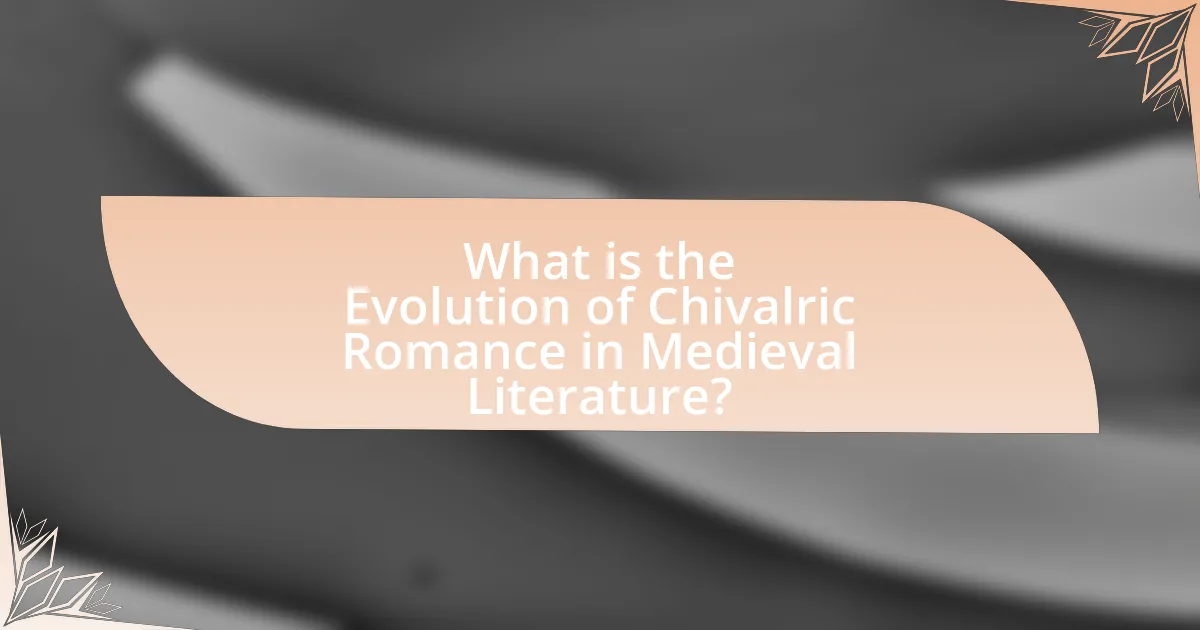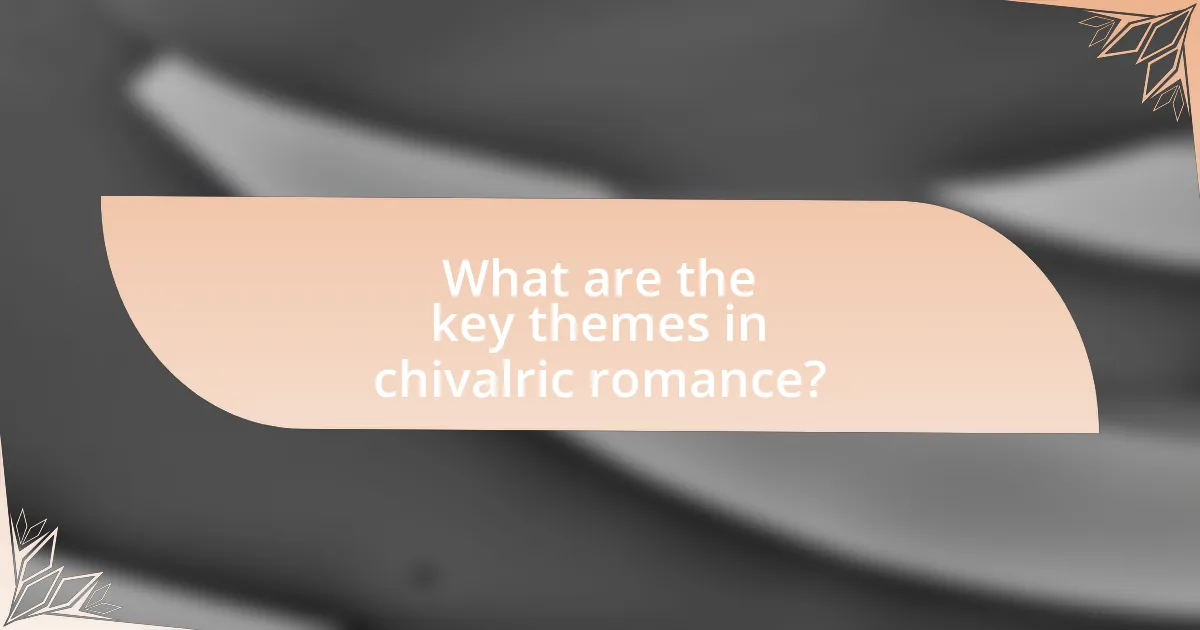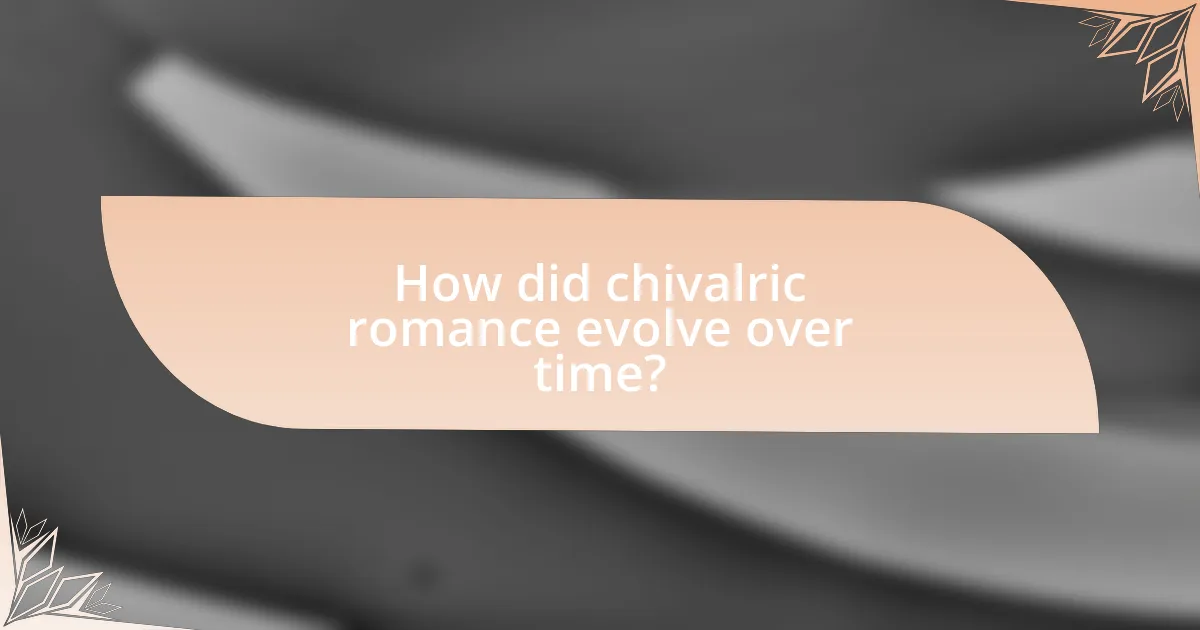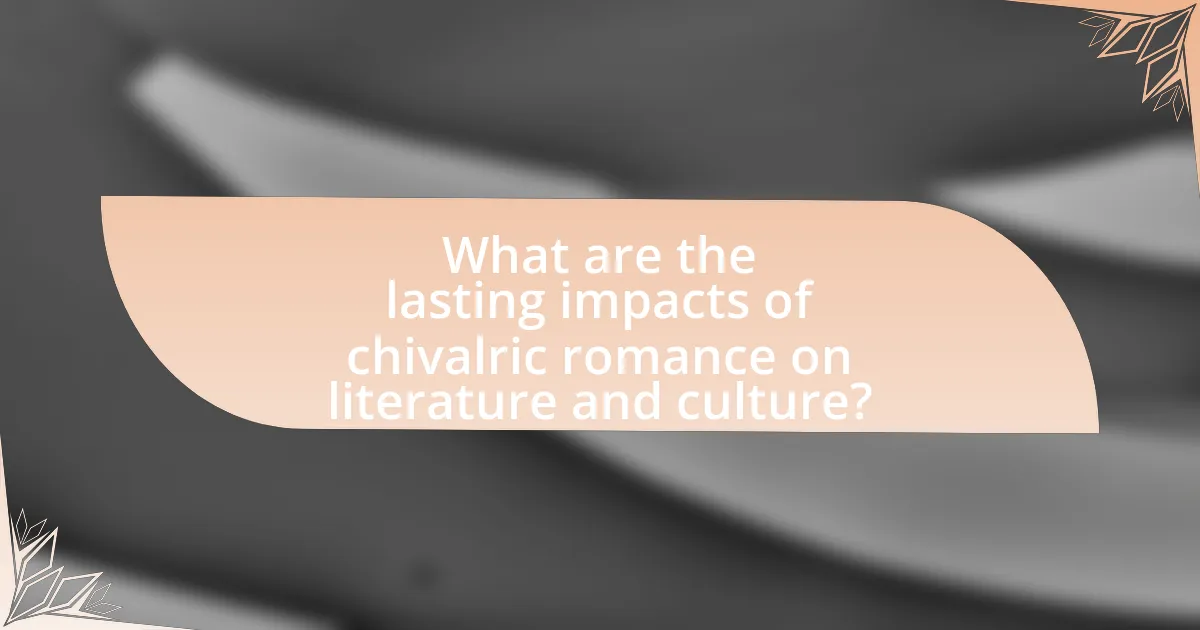The article examines the evolution of chivalric romance in medieval literature, tracing its development from the 12th to the 15th centuries. It highlights the emergence of this genre through early works like “Erec and Enide,” the incorporation of fantasy elements in texts such as “Sir Gawain and the Green Knight,” and the synthesis of Arthurian legends in Thomas Malory’s “Le Morte d’Arthur.” The article discusses the historical and cultural factors that influenced chivalric romance, its defining characteristics, and its significance in reflecting societal values of honor, bravery, and courtly love. Additionally, it explores the portrayal of female characters, the impact of regional variations, and the lasting influence of chivalric romance on modern literature and culture.

What is the Evolution of Chivalric Romance in Medieval Literature?
The evolution of chivalric romance in medieval literature reflects the changing ideals of knighthood and courtly love from the 12th to the 15th centuries. Initially, chivalric romance emerged in the 12th century with works like “Erec and Enide” by Chrétien de Troyes, which introduced themes of adventure, honor, and the quest for love. As the genre developed, it incorporated elements of fantasy and supernatural occurrences, exemplified by texts such as “Sir Gawain and the Green Knight,” which emphasized moral and ethical dilemmas faced by knights.
By the late medieval period, chivalric romance began to blend with other literary forms, leading to more complex narratives and character development. The works of authors like Thomas Malory, particularly “Le Morte d’Arthur,” synthesized earlier traditions and established a more cohesive Arthurian legend, highlighting the ideals of loyalty, bravery, and the tragic consequences of love and betrayal. This evolution illustrates how chivalric romance not only entertained but also served as a reflection of societal values and the changing perceptions of heroism and morality in medieval culture.
How did chivalric romance emerge in medieval literature?
Chivalric romance emerged in medieval literature as a distinct genre during the 12th century, primarily influenced by the ideals of chivalry and courtly love. This genre developed from earlier narrative traditions, such as epic poetry and folklore, which celebrated heroic deeds and noble characters. The introduction of courtly love, as articulated by poets like Andreas Capellanus, further shaped the themes and characterizations within chivalric romances, emphasizing the emotional and moral complexities of love and honor. Notable works, such as “The Song of Roland” and the Arthurian legends, exemplify the fusion of these elements, showcasing knights undertaking quests that reflect both personal and societal values of the time.
What historical and cultural factors influenced the rise of chivalric romance?
The rise of chivalric romance was influenced by the feudal system, the Crusades, and the cultural shift towards courtly love in medieval Europe. The feudal system established a hierarchy that emphasized loyalty and valor among knights, which became central themes in chivalric literature. The Crusades, occurring from the late 11th to the late 13th centuries, inspired tales of heroism and adventure, as knights sought to prove their bravery and honor in foreign lands. Additionally, the cultural shift towards courtly love, particularly in the 12th century, introduced ideals of romantic love and devotion, which were often depicted in chivalric romances, blending the notions of knightly duty with personal affection. These factors collectively shaped the narratives and themes prevalent in chivalric romance, reflecting the values and aspirations of medieval society.
What are the defining characteristics of chivalric romance?
Chivalric romance is characterized by themes of knightly valor, courtly love, and moral quests. These narratives often feature knights embarking on adventures to prove their bravery and uphold chivalric ideals, such as loyalty and honor. The portrayal of courtly love emphasizes the idealization of women and the emotional struggles of the knight, often leading to trials that test their character. Additionally, supernatural elements and fantastical creatures frequently appear, enhancing the sense of adventure and moral complexity. Historical examples, such as “Sir Gawain and the Green Knight,” illustrate these characteristics through the protagonist’s journey that intertwines personal honor with societal expectations.
Why is chivalric romance significant in medieval literature?
Chivalric romance is significant in medieval literature because it encapsulates the ideals of knighthood, courtly love, and moral virtue, reflecting the social values of the time. These narratives often served as both entertainment and moral instruction, illustrating the complexities of human relationships and the pursuit of honor. For instance, works like “Sir Gawain and the Green Knight” and “The Romance of the Rose” not only entertained audiences but also reinforced the cultural norms surrounding chivalry and ethical conduct. The popularity of chivalric romance during the medieval period indicates its role in shaping societal expectations and influencing the literary canon, making it a crucial component of medieval literary studies.
How does chivalric romance reflect the values of medieval society?
Chivalric romance reflects the values of medieval society by emphasizing ideals such as honor, bravery, loyalty, and courtly love. These narratives often depict knights undertaking quests that showcase their valor and commitment to their lords and ladies, aligning with the feudal system’s hierarchical structure. For instance, works like “Sir Gawain and the Green Knight” illustrate the importance of chivalric virtues, where Gawain’s journey embodies the moral and ethical standards expected of a knight. Additionally, the portrayal of courtly love in these romances reinforces social norms regarding gender roles and the veneration of women, as seen in texts like “The Knight’s Tale” by Geoffrey Chaucer. Thus, chivalric romances serve as a mirror to the societal values of loyalty, honor, and the idealization of romantic relationships prevalent in medieval culture.
What role did chivalric romance play in shaping literary traditions?
Chivalric romance significantly influenced the development of literary traditions by establishing narrative structures and themes that emphasized heroism, courtly love, and moral ideals. These narratives, originating in the medieval period, provided a framework for storytelling that combined adventure with ethical dilemmas, shaping the expectations of readers and writers alike. For instance, works like “Le Morte d’Arthur” by Sir Thomas Malory not only popularized the Arthurian legends but also set a standard for character development and plot progression in subsequent literature. The emphasis on chivalric values in these romances laid the groundwork for later literary movements, including the Renaissance and the rise of the novel, demonstrating their lasting impact on narrative forms and cultural ideals.

What are the key themes in chivalric romance?
The key themes in chivalric romance include love, honor, bravery, and the quest for identity. Love often manifests as a noble pursuit, driving knights to undertake perilous adventures to win the affection of their ladies. Honor is central to the knightly code, dictating that knights must act with integrity and uphold their reputation. Bravery is exemplified through heroic deeds and battles against formidable foes, showcasing the knight’s valor. The quest for identity often involves self-discovery, where characters confront their values and beliefs in the context of their societal roles. These themes are evident in works such as “Sir Gawain and the Green Knight,” where Gawain’s journey encapsulates the interplay of love, honor, and personal growth.
How do love and honor manifest in chivalric romance?
Love and honor in chivalric romance manifest through the ideals of courtly love and the knightly code of conduct. Courtly love emphasizes the noble pursuit of affection, often characterized by unattainable love, which drives knights to perform heroic deeds to win the favor of their beloved. This is evident in works like “Lancelot and Guinevere,” where Lancelot’s love for Guinevere motivates his actions and sacrifices.
Honor, on the other hand, is represented by the knight’s commitment to loyalty, bravery, and moral integrity, as seen in the chivalric code that dictates a knight’s behavior. For instance, in “The Song of Roland,” Roland’s honor compels him to fight valiantly even in the face of certain death, showcasing the intertwining of personal valor and societal expectations.
Together, love and honor create a framework that defines the actions and motivations of characters in chivalric romance, illustrating the cultural values of the medieval period.
What are the common tropes associated with love in chivalric tales?
Common tropes associated with love in chivalric tales include courtly love, the idealization of the beloved, and the trials faced by lovers. Courtly love often portrays a knight’s devotion to a lady, emphasizing loyalty and service, as seen in works like “The Song of Roland.” The idealization of the beloved elevates the lady to an almost divine status, inspiring knights to perform noble deeds. Additionally, trials faced by lovers, such as obstacles imposed by social norms or rival suitors, are prevalent, reflecting the tension between desire and duty, as illustrated in “Tristan and Isolde.” These tropes collectively shape the narrative structure and thematic depth of chivalric romance.
How is the concept of honor portrayed in the actions of knights?
The concept of honor is portrayed in the actions of knights as a fundamental principle guiding their behavior and decisions. Knights are depicted as upholding values such as bravery, loyalty, and integrity, often engaging in battles or quests to defend the weak and uphold justice. For instance, in medieval literature, characters like Sir Lancelot and Sir Gawain exemplify honor through their commitments to their lords and their adherence to the chivalric code, which emphasizes the importance of reputation and moral conduct. Historical texts, such as “Le Morte d’Arthur” by Sir Thomas Malory, illustrate how knights’ actions are driven by the desire to maintain their honor, often leading them to face dire consequences for their choices, thereby reinforcing the societal expectation that honor is paramount in a knight’s life.
What role do female characters play in chivalric romance?
Female characters in chivalric romance serve as pivotal figures that embody ideals of virtue, beauty, and moral integrity, often acting as the motivation for knights’ quests and heroic deeds. These women frequently represent the ultimate prize or goal for male protagonists, symbolizing the chivalric values of honor and loyalty. For instance, in works like “Sir Gawain and the Green Knight,” Lady Bertilak plays a crucial role in testing Gawain’s character, illustrating how female figures can influence the narrative and the development of male heroes. Additionally, female characters often possess their own agency and complexity, as seen in “The Romance of the Rose,” where women express desires and assert their influence, challenging the traditional passive roles assigned to them. This duality highlights the evolving portrayal of women in medieval literature, reflecting broader societal views on gender and morality during the chivalric period.
How are women depicted in chivalric narratives?
Women in chivalric narratives are often depicted as idealized figures representing purity, virtue, and the object of knights’ quests. These narratives frequently portray women as damsels in distress, requiring rescue, which reinforces traditional gender roles. For instance, in works like “Sir Gawain and the Green Knight,” women such as Lady Bertilak embody both temptation and moral testing for the male protagonist, illustrating their complex roles in the narrative. Additionally, texts like “The Romance of the Rose” depict women as both powerful and influential, yet still largely confined to the ideals of courtly love, emphasizing their status as objects of admiration rather than active agents. This duality reflects the societal views of women during the medieval period, where they were revered yet constrained by patriarchal norms.
What influence do female characters have on the development of male protagonists?
Female characters significantly influence the development of male protagonists by shaping their motivations, moral dilemmas, and personal growth. In chivalric romance, female figures often serve as catalysts for male heroes, prompting them to undertake quests or confront their inner conflicts. For example, in works like “Sir Gawain and the Green Knight,” the character of Lady Bertilak challenges Gawain’s honor and integrity, forcing him to navigate complex ethical choices that ultimately lead to his character development. This dynamic illustrates how female characters not only drive the narrative forward but also facilitate the male protagonists’ journey toward self-discovery and maturity.

How did chivalric romance evolve over time?
Chivalric romance evolved from early medieval narratives focused on heroic deeds and courtly love to more complex stories that incorporated themes of individualism and moral dilemmas. Initially, chivalric romances, such as those found in the works of Chrétien de Troyes in the 12th century, emphasized the ideals of knighthood, loyalty, and the quest for honor. Over time, particularly during the late medieval period, these romances began to reflect societal changes, including the rise of the bourgeoisie and a shift towards more personal and psychological character development, as seen in the later works of authors like Sir Thomas Malory in “Le Morte d’Arthur.” This evolution was marked by a transition from purely fantastical elements to narratives that explored the complexities of human relationships and ethical challenges, illustrating the changing values of medieval society.
What changes occurred in the portrayal of knights throughout the medieval period?
The portrayal of knights evolved significantly throughout the medieval period, transitioning from brutal warriors to idealized figures embodying chivalric virtues. Initially, knights were depicted primarily as skilled fighters focused on martial prowess and loyalty to their lords, often engaging in violent conflicts. By the late medieval period, literature began to emphasize qualities such as honor, courtly love, and moral integrity, reflecting the influence of chivalric codes. This shift is evident in works like “The Song of Roland,” which highlights loyalty and bravery, compared to later texts like “Sir Gawain and the Green Knight,” where the knight’s character is tested through moral dilemmas and personal honor. This evolution illustrates a broader cultural shift towards valuing ethical conduct and romantic ideals alongside martial skill.
How did the ideals of knighthood transform from the early to late medieval period?
The ideals of knighthood transformed significantly from the early to late medieval period, shifting from a focus on martial prowess and loyalty to a more complex code of chivalry that emphasized courtly behavior, honor, and romantic ideals. In the early medieval period, knights were primarily valued for their military skills and loyalty to their lords, as evidenced by the feudal system where service in battle was paramount. By the late medieval period, literature such as “The Song of Roland” and “Sir Gawain and the Green Knight” illustrated a broader chivalric code that included virtues like bravery, courtesy, and respect for women, reflecting the influence of courtly love and the rise of a more sophisticated social structure. This evolution was further supported by the establishment of chivalric orders and the increasing importance of personal honor and ethical conduct in knightly behavior.
What impact did historical events have on the evolution of chivalric romance?
Historical events significantly shaped the evolution of chivalric romance by influencing its themes, characters, and societal values. The Crusades, for instance, introduced the ideals of knightly valor and religious devotion, which became central to chivalric narratives, as seen in works like “The Song of Roland.” Additionally, the rise of courtly love during the 12th century, influenced by the social structures of feudalism and the role of women in aristocratic circles, led to the incorporation of romantic elements in chivalric tales, exemplified in “Lancelot” and “Tristan and Isolde.” Furthermore, the Hundred Years’ War and the shifting political landscapes in Europe prompted authors to reflect on national identity and heroism, which further evolved the genre. These historical contexts provided a framework that enriched the narratives, making them resonate with contemporary audiences while reflecting the complexities of medieval society.
How did regional variations affect chivalric romance?
Regional variations significantly influenced chivalric romance by shaping the themes, characters, and cultural contexts within different regions. For instance, in France, chivalric romances often emphasized courtly love and the ideals of knighthood, as seen in works like “Lancelot” and “Tristan and Isolde,” which reflect the French court’s values. In contrast, English chivalric romances, such as “Sir Gawain and the Green Knight,” incorporated local folklore and moral lessons, highlighting the importance of honor and integrity in a distinctly English context. These regional differences illustrate how local customs, societal norms, and historical events informed the narratives and characterizations in chivalric literature, leading to diverse interpretations and expressions of the chivalric ideal across Europe.
What are the differences between French and English chivalric romances?
French and English chivalric romances differ primarily in their thematic focus and narrative style. French romances, such as those by Chrétien de Troyes, often emphasize courtly love, intricate plots, and the ideals of knighthood, showcasing a blend of adventure and moral lessons. In contrast, English romances, exemplified by works like Sir Gawain and the Green Knight, tend to highlight individual heroism, moral integrity, and the challenges of personal honor, often incorporating elements of folklore and local culture. These distinctions reflect broader cultural values, with French literature leaning towards the refinement of courtly life and English literature emphasizing the ruggedness and moral dilemmas faced by knights.
How did local cultures influence the themes and characters in chivalric tales?
Local cultures significantly influenced the themes and characters in chivalric tales by embedding regional values, customs, and social hierarchies into the narratives. For instance, the ideals of courtly love prevalent in French literature shaped character motivations and relationships, while Germanic traditions emphasized honor and loyalty, impacting the portrayal of knights. Additionally, local folklore and historical events often provided the backdrop for these tales, allowing for the integration of specific cultural elements, such as Arthurian legends in Britain, which reflected the societal norms and aspirations of the time. This cultural interplay is evident in works like “Sir Gawain and the Green Knight,” where the blend of Celtic mythology and chivalric ideals illustrates the local cultural context’s role in shaping the narrative.

What are the lasting impacts of chivalric romance on literature and culture?
Chivalric romance has profoundly influenced literature and culture by establishing themes of heroism, courtly love, and moral ideals. These narratives shaped the development of character archetypes and plot structures in Western literature, evident in works such as Sir Gawain and the Green Knight and later in the novels of the Renaissance and beyond. The emphasis on chivalric values, such as honor and loyalty, permeated cultural norms and social expectations, influencing the portrayal of relationships and ethical conduct in society. Furthermore, the romanticized ideals of knighthood and noble quests have persisted in modern storytelling, impacting genres like fantasy and romance, as seen in contemporary works such as J.R.R. Tolkien’s The Lord of the Rings and George R.R. Martin’s A Song of Ice and Fire. This enduring legacy highlights the foundational role of chivalric romance in shaping literary traditions and cultural narratives.
How has chivalric romance influenced modern storytelling?
Chivalric romance has significantly influenced modern storytelling by establishing foundational themes such as heroism, courtly love, and moral quests. These narratives often center around a noble knight’s adventures, reflecting ideals of bravery and honor, which continue to resonate in contemporary literature and film. For example, modern fantasy series like “The Lord of the Rings” and “Game of Thrones” draw heavily from the archetypes and narrative structures found in chivalric romances, showcasing quests, battles, and complex character relationships. Additionally, the emphasis on personal growth and ethical dilemmas in chivalric tales has shaped character development in modern narratives, illustrating the enduring legacy of these medieval stories in shaping the moral frameworks of today’s storytelling.
What elements of chivalric romance can be found in contemporary literature and media?
Contemporary literature and media often incorporate elements of chivalric romance, such as the ideals of heroism, courtly love, and quests. These elements manifest in various forms, including the portrayal of noble characters who embark on adventures to prove their valor and win the affection of a beloved. For instance, modern fantasy novels like “The Name of the Wind” by Patrick Rothfuss feature protagonists who exhibit chivalric traits, such as bravery and loyalty, while navigating complex romantic relationships. Additionally, films like “The Princess Bride” blend humor with traditional chivalric themes, showcasing a hero’s journey and the pursuit of true love. These examples illustrate how the core components of chivalric romance continue to resonate in contemporary storytelling, reflecting enduring cultural values.
How do modern interpretations of chivalric romance differ from their medieval origins?
Modern interpretations of chivalric romance differ from their medieval origins primarily in their focus on character development and psychological complexity rather than solely on ideals of honor and valor. While medieval chivalric romances often emphasized heroic deeds and the pursuit of courtly love, modern adaptations frequently explore themes of personal struggle, moral ambiguity, and the subversion of traditional gender roles. For example, contemporary works may portray knights as flawed individuals facing internal conflicts, contrasting with the idealized, one-dimensional heroes of medieval texts. This shift reflects broader societal changes in understanding human relationships and individual identity, as seen in novels and films that challenge the simplistic dichotomy of good versus evil prevalent in earlier narratives.
What lessons can be learned from the study of chivalric romance?
The study of chivalric romance teaches lessons about the ideals of honor, loyalty, and the complexities of love and duty. These narratives often illustrate the moral dilemmas faced by knights, emphasizing the importance of personal integrity and the consequences of choices made in the name of love or honor. For instance, characters like Sir Lancelot in “Le Morte d’Arthur” grapple with the conflict between their romantic desires and their obligations to their king and comrades, showcasing the tension between personal fulfillment and societal expectations. This reflects the historical context of medieval society, where chivalric codes dictated behavior and shaped social norms, thus providing insight into the values and challenges of that era.
How can understanding chivalric romance enhance our appreciation of medieval literature?
Understanding chivalric romance enhances our appreciation of medieval literature by providing insight into the cultural values and social norms of the time. Chivalric romances often reflect ideals such as honor, bravery, and courtly love, which were central to medieval society. For instance, works like “Sir Gawain and the Green Knight” illustrate the complexities of knightly conduct and moral dilemmas, allowing readers to grasp the ethical frameworks that shaped medieval life. This genre also serves as a lens through which we can examine the interplay between individual desires and societal expectations, enriching our comprehension of the historical context in which these texts were produced. By analyzing the themes and character archetypes within chivalric romances, readers can better understand the literary techniques and narrative structures that define medieval literature, ultimately deepening their engagement with the period’s literary heritage.
What insights does chivalric romance provide about human nature and society?
Chivalric romance reveals that human nature is driven by ideals of honor, love, and bravery, while society is structured around these values, emphasizing the importance of social status and moral conduct. The narratives often depict knights undertaking quests that reflect personal growth and the pursuit of noble ideals, illustrating the tension between individual desires and societal expectations. For instance, the tales of King Arthur and the Knights of the Round Table highlight the virtues of loyalty and chivalry, which were essential for maintaining social order in medieval society. These stories serve as a mirror to the cultural values of the time, showcasing how individuals navigate their roles within a hierarchical structure while striving for personal virtue and societal approval.